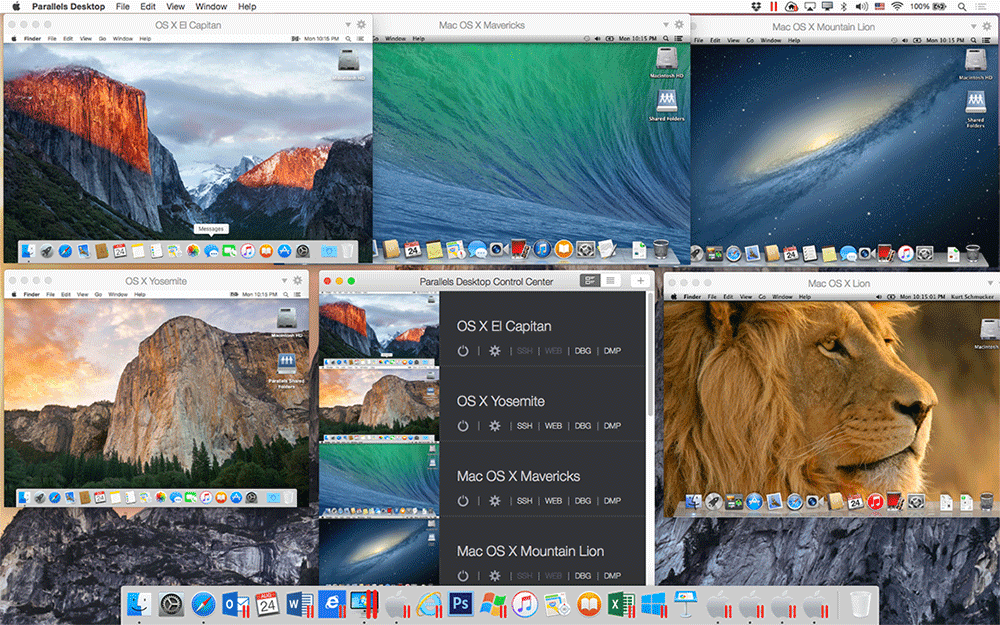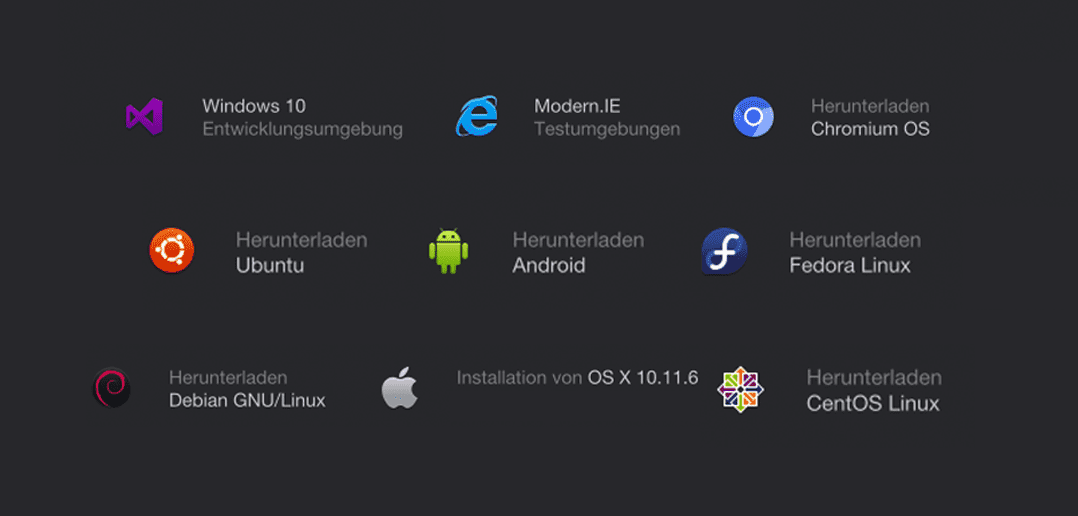VMware will include support for Mac OS X Leopard Server in VMware Fusion’s next beta. The next version of VMware Fusion will add support for Mac OS 10.5 Leopard. Unsure About an Acronym or Term? Search the ServerWatch Glossary Users will be able to run as many copies of Mac OS X Server on.
- Parallels Desktop 16 for Mac is the fastest, easiest, and most powerful application for running Windows applications on a Mac without rebooting. Parallels Desktop 16 now supports Big Sur 11.0, Sidecar, and DirectX 11. Mac OS X Snow Leopard Server 10.6.x; Mac OS X Leopard Server 10.5.x.
- Is a developer of desktop and server virtualization software. Released on June 15, 2006, it was the first software product to bring mainstream virtualization to Macintosh computers utilizing the Apple–Intel architecture (earlier software products ran PC software in an emulated environment). Its name initially was 'Parallels Workstation for Mac OS X', which.
- Run Windows and other operating systems simultaneously with Mac OS X. Parallels Desktop for Mac.a important application, Parallels Desktop for Mac. The first Memory Cleaner on the Mac App Store! Photographers - Scientists - Parallels Desktop users - For.
- Make Offer - Mac OS X Snow Leopard New Version 10.6.3 Sealed, ships via Priority Mail Parallels Desktop 6 for Mac Run Windows applications on Mac without rebooting $19.99.

Parallels Server for Mac running Mac OS X Leopard Server in a VM on top of Mac OS X Leopard Server | |
| Developer(s) | Parallels, Inc. |
|---|---|
| Stable release | |
| Operating system | Mac OS X Server |
| Platform | Apple–Intel architecture |
| Available in | Multilingual[which?] |
| Type | Hypervisor |
| License | Proprietary |
| Website | parallels.com/products/server/mac/ |
Parallels Server for Mac is a server-sidedesktop virtualization product built for the Mac OS X Server platform and is developed by Parallels, Inc., a developer of desktop virtualization and virtual private server software. This software allows users to run multiple distributions of Linux, Windows and FreeBSD server applications alongside Mac OS X Server on Intel-based Apple hardware.
Parallels Server for Mac was not in development for more than a year[1] before its alpha stage was demoed at MacWorld 2008 [2] and the product was officially released on June 17, 2008.[3] While in beta, Parallels Server for Mac did not allow running Mac OS X Server in a virtual machine; however, Apple eased up on its licensing restrictions before Parallels Server for Mac's GA release to allow running Mac OS X Leopard Server in a virtual machine as long as that virtual machine is running on Apple hardware.[4]
Overview[edit]
Similar to Parallels Desktop for Mac, Parallels Server for Mac is a hypervisor-based server virtualization software that allows users to run multiple guest operating systems, each in a virtual machine, alongside a primary or 'host' operating system. The product's hypervisor allows each virtual machine to function as a standalone server with its own virtualized hardware, memory and processor. However, unlike the desktop software, Parallels Server for Mac is a hardware-optimized enterprise product designed to handle server workloads such as databases and enterprise email and is aimed at the professional market rather than the consumer market.[5] Parallels Server for Mac allows users to run Intel-powered Apple hardware in a business environment without isolating the Mac servers from the organization's Windows and Linux systems.
Pixelmator for mac download. We need LARGE and EASY TO READ! Can you PLEASE help us senior citizens out and improve the interface? It does everyting I wanted - and more- but it is exhausting for me to use. Red Grange, Lacks some essentialsI like to create artwork rom scratch and have all of the major programs (like Phosotshop, Illustrator, Painter, Sketchbook Pro and Pixelmator). I get tired and give up on it many times.
System requirements[edit]

- Intel-powered Mac server or desktop computer running Mac OS X Server Leopard
- Minimum 2 GB RAM
- 40.5 MB hard disk space for Parallels Server for Mac
- Minimum 150 GB for VM files and virtual hard disks
- Optical drive
- Ethernet or FireWire network adapter
Key features[edit]
Users can run 32- and 64-bit guest operating systems such as Mac OS X Server, Windows, Linux, and Apple UNIX runtime for Xserve and DTK in virtual machines on Apple Xserves and Mac Pros.Parallels Server for Mac comes with Parallels Tools, Parallels Transporter for P2V and V2V migration and Parallels Disk Image tool for modifying the size of virtual disks. Also included are the Parallels Management Console, which allows server administrators to manage the virtual machines both locally and remotely[3] and Parallels Explorer, which allows access to virtual machines without launching the guest operating system.
Additional features include:
- Virtual support for 4-way Symmetric Multi-processing (4-way SMP)
- Up to 32 GB of physical RAM
- 64 MB memory support with up to 8 GB guest memory
- Supports virtual guest disk sizes up to 2 TB
- Supports Intel Virtualization Technology (Intel VT-x)) hardware acceleration
- Advanced Configuration and Power Interface (ACPI) support in VMs
- SDK that enables third-party vendors to incorporate support for Parallels Server for Mac into their own products
- SNMP, Command line interface (CLI)
- VM Assistant to create new virtual machines
Limitations[edit]
Parallels Server for Mac can run only on Intel-based Apple hardware which must be running Mac OS X Leopard Server, not Mac OS X Tiger Server or on PC hardware. Also, at this time, users cannot run Mac OS X versions newer than 10.6 in a virtual environment due to Apple licensing restrictions. Also Mac OS X 10.7 (Lion) and 10.8 (Mountain Lion) and 10.9 (Mavericks) cannot be virtualized with this software.
See also[edit]
References[edit]
- ^Parallels demos Mac server virtualization
- ^Macworld | Parallels Server for Mac demoed at WWDC
- ^ abParallels Server for Mac Announced || The Mac Observer
- ^Virtualization Report | David Marshall | InfoWorld | Parallels announces the first Mac server virtualization platform | June 18, 2008 08:14 AM | David MarshallArchived June 19, 2008, at the Wayback Machine
- ^Parallels Server for Mac available now - The Unofficial Apple Weblog (TUAW)
External links[edit]
Update: The below was tested on Parallels Desktop 6. Commenters have reported that it doesn’t work on Parallels Desktop 7. I’ll be taking a closer look at some point.
One bit of under-the-radar good news in Lion is that Apple has changed the licensing terms of their End User License Agreement: they now permit you to run Mac OS X, either the regular or Server version, on up to two virtual machines, as long as they are running on Mac hardware. In Snow Leopard, only the Server version was permitted to be virtualized.


However, there’s now a very good reason to want to run Snow Leopard in a VM: Lion doesn’t support PowerPC applications. So having Snow Leopard around would allow you to continue to use these older applications. Parallels only lets you install the Server version of Snow Leopard.

But a while ago someone figured out that if you can get a Snow Leopard installation into a virtual HD, and create an empty file called /System/Library/CoreServices/ServerVersion.plist, it would boot. So the trick is to figure out how to get Snow Leopard into a Parallels virtual HD (.hdd file). Another person figured out that if you installed Snow Leopard Server first, and from there installed standard Snow Leopard, that would work; but what I wanted was not have to install Snow Leopard Server first, or in fact need it at all.
So I figured out a couple of methods. They have been tested with Parallels Desktop 6 but ought to work equally well in VMWare Fusion or Oracle VirtualBox. One method is faster, but requires a Snow Leopard Server install disc, though not a license key for it. (This might apply if your license key expires after a certain date, or is already in use on another machine; you won’t actually be installing Snow Leopard Server.) The other way requires only a regular Snow Leopard DVD, but also needs an 8 GB flash drive and it takes longer. I’ll explain the first way here, and the second way tomorrow.
(Keep in mind that it’s only me, Ivan Drucker, and not IvanExpert the company, explaining how to do this, and I’m not recommending it. Since the release of Lion, it’s now a murky area as to whether doing this is kosher per Apple’s EULA. I am not a lawyer, I am not responsible for anything that happens, etc, etc.)
If you have a Snow Leopard Server DVD:
Mac Leopard Os
- Use Disk Utility to make disk image files from both the Server DVD and the standard Mac OS X DVD.
- Create a new VM. Choose “Continue Without Disc” and then choose “Mac OS X Server 10.6” as the type of virtual machine, and select “Customize Settings Before Installation”.
- In the configuration window, click on Hardware. Click on CD/DVD and assign the Snow Leopard Server disk image to it.
- Add another virtual CD/DVD drive, and assign the standard Snow Leopard disk image to it.
- Click Hard Disk 1. This will be your Snow Leopard virtual HD. If you want it to be larger than the default which Parallels created, either edit it, or just delete the drive and add back a new one.
- Click OK and start the VM. Snow Leopard Server Install will start up. Click until you get to the screen where it asks which hard disk you want to install to.
- Go to the Utilities menu and choose Terminal. On a single line, including the single quote marks, type: cd ‘/Volumes/Mac OS X Install DVD/System/Installation/Packages’
- Type: installer -verbose -pkg OSInstall.mpkg -tgt ‘/Volumes/Macintosh HD’ (explained here)
- Snow Leopard will begin installing to the virtual HD. You will see nothing but “Installing Files” and other notices for a while, possibly over an hour.
- Type: touch ‘/Volumes/Macintosh HD/System/Library/CoreServices/ServerVersion.plist’
- Type: shutdown -h now
That should be it. Fire up the virtual machine, and you should be running the regular version of Snow Leopard.
One thing to be aware of is that the presence of the file /System/Library/CoreServices/ServerVersion.plist causes at least two side effects: A) Software Update won’t offer you many updates that it is supposed to, and B) the Sharing system preference pane hides many of its settings.
So before using either, you should remove that file, but be sure to put it back when you’re done, or the VM won’t start up. If you do find yourself in that situation, booting from the the Snow Leopard Server disk image, opening Terminal, and then typing the commands in steps 10-11 above should fix it. This blog post also suggests a script which takes care of creating and deleting it automatically; I haven’t (yet) tried it.
Parallels Desktop 10 For Mac
Ok: tomorrow I’ll explain how to do it without needing the Server disk.
